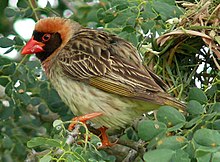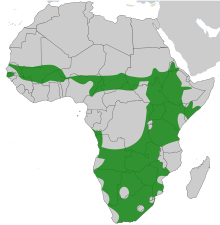| Red-billed quelea | |
|---|---|

| |
| Male breeding plumage of Q. q. lathamii | |

| |
| Non-breeding plumage | |
| Scientific classification | |
| Domain: | Eukaryota |
| Kingdom: | Animalia |
| Phylum: | Chordata |
| Class: | Aves |
| Order: | Passeriformes |
| Family: | Ploceidae |
| Genus: | Quelea |
| Species: | Q. quelea
|
| Binomial name | |
| Quelea quelea | |

| |
rough distribution[2]
| |
| Synonyms | |
| |
The red-billed quelea (/ˈkwiːliə/;[3] Quelea quelea), also known as the red-billed weaver or red-billed dioch, is a small—approximately 12 cm (4.7 in) long and weighing 15–26 g (0.53–0.92 oz)—migratory, sparrow-like bird of the weaver family, Ploceidae, native to Sub-Saharan Africa.
It was named by Linnaeus in 1758, who considered it a bunting, but Ludwig Reichenbach assigned it in 1850 to the new genus Quelea. Three subspecies are recognised, with Quelea quelea quelea occurring roughly from Senegal to Chad, Q. q. aethiopica from Sudan to Somalia and Tanzania, and Q. q. lathamii from Gabon to Mozambique and South Africa. Non-breeding birds have light underparts, striped brown upper parts, yellow-edged flight feathers and a reddish bill. Breeding females attain a yellowish bill. Breeding males have a black (or rarely white) facial mask, surrounded by a purplish, pinkish, rusty or yellowish wash on the head and breast. The species avoids forests, deserts and colder areas such as those at high altitude and in southern South Africa. It constructs oval roofed nests woven from strips of grass hanging from thorny branches, sugar cane or reeds. It breeds in very large colonies.
The quelea feeds primarily on seeds of annual grasses, but also causes extensive damage to cereal crops. Therefore, it is sometimes called "Africa's feathered locust".[4] The usual pest-control measures are spraying avicides or detonating fire-bombs in the enormous colonies during the night. Extensive control measures have been largely unsuccessful in limiting the quelea population. When food runs out, the species migrates to locations of recent rainfall and plentiful grass seed; hence it exploits its food source very efficiently. It is regarded as the most numerous undomesticated bird on earth, with the total post-breeding population sometimes peaking at an estimated 1.5 billion individuals. It feeds in huge flocks of millions of individuals, with birds that run out of food at the rear flying over the entire group to a fresh feeding zone at the front, creating an image of a rolling cloud. The conservation status of red-billed quelea is least concern according to the IUCN Red List.
- ^ BirdLife International (2016). "Quelea quelea". IUCN Red List of Threatened Species. 2016: e.T22719128A94613042. doi:10.2305/IUCN.UK.2016-3.RLTS.T22719128A94613042.en.
- ^ "Red-billed quelea". Handbook of Birds of the World Alive. doi:10.2173/bow.rebque1.01. S2CID 216311213. Retrieved 11 May 2017.
- ^ "Quelea". Random House Webster's Unabridged Dictionary.
- ^ Cite error: The named reference
WWwas invoked but never defined (see the help page).
